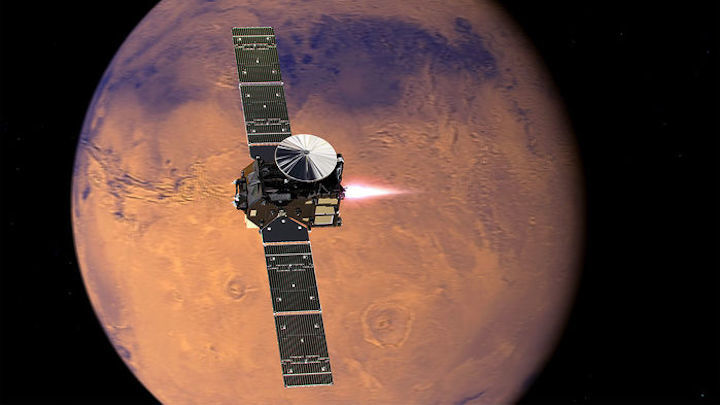14.12.2018

Mars’s methane has gone missing. Scientists first detected traces of the gas—a critical indicator of life on Earth—in the planet’s atmosphere decades ago. But today, researchers reported that a European satellite hasn’t spotted a single trace of methane. The finding, if it holds up, could complicate scientific dreams that martian microbes might be spewing the gas in the planet’s subsurface.
The Mars Express orbiter first detected hints of methane in the martian atmosphere in 2004. But some scientists said the orbiter’s instruments that found it—at a level of 10 parts per billion (ppb)—weren’t sensitive enough to produce reliable results. Ten years later, NASA’s Curiosity rover detected a methane spike of 7 ppb from its base in Gale crater, which lasted several months. Several years later, Curiosity’s scientists then discovered a minute seasonal cycle, with methane levels peaking at 0.7 ppb in the late northern summer.
To settle this mystery, the European Space Agency’s Trace Gas Orbiter (TGO), which arrived at Mars in 2016, this year began to scan the atmosphere for methane. Two of the TGO’s spectrometers—a Belgian instrument called NOMAD and a Russian one called ACS—were designed to detect methane in such low concentrations that researchers were sure they would. Both instruments, which analyze horizontal slices of the martian atmosphere backlit by the sun, are working well, scientists on the team said today at a semiannual meeting of the American Geophysical Union in Washington, D.C. There’s still some noise to clean up, said Ann Carine Vandaele, NOMAD’s principal investigator and a planetary scientist at the Royal Belgian Institute for Space Aeronomy in Brussels, in her talk. “But we already know we can’t see any methane.”
The team’s initial results show no detection of methane down to a minute level of 50 parts per trillion, with their observations going down nearly all the way to the martian surface.
The results are a surprise, says Chris Webster, a planetary scientist at the Jet Propulsion Laboratory in Pasadena, California, who leads the methane-sensing instrument on Curiosity. He expected the TGO to pick up at least a 0.2-ppb signal. But he’s still optimistic: It took his team 6 months to detect the methane spike and years to find the seasonal background methane cycle. “I’m confident that over time there will be a consistency between the two data sets.”
The Curiosity team suspects the methane cycle comes from microseeps in the planet’s subsurface, either from living or geological sources, not from outside the planet. The TGO could validate that, given that it seems to show no methane falling down through the atmosphere. “The methane is not coming from above,” Webster says. “That’s a big result.”
It’s also confusing: For example, scientists suspect that hundreds of tons of organic carbon pour into the martian atmosphere each year from solar system dust, reacting with solar radiation to form methane, say John Moores, a planetary scientist at York University in Toronto, Canada. “Where is all that carbon going?”
Gale crater is unlikely to be the only spot on Mars to see such seeps, says Sushil Atreya, a planetary scientist at the University of Michigan in Ann Arbor and a member of the Curiosity science team. But even if there are 5000 similar seeps, the signal that mixes into the atmosphere will be small. “I actually did the calculation,” he says. “It’s going to average out to be a very, very low value, nondetectable.”
For now, the methane mystery has only deepened. The TGO will keep running until 2022, enough to capture at least a couple martian years. Its data will grow more precise and its detection limits will drop. And perhaps then scientists will know whether their hopes for methane-spewing microbes, already on life support, have reached an end.
Quelle: Science

